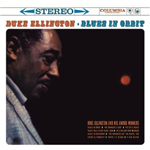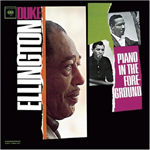| |
Duke
Ellington : 2004 Reissues (Part 2)
by Jay Collins
August 2004
As discussed in the previous One Final Note coverage of Sony’s
2004 reissues of material from Duke Ellington’s final tenure
with Columbia, Duke was riding a high due to the return of Johnny
Hodges, the success of his 1956 Newport Jazz Festival appearance and
the existence of a solid record deal with Columbia. Arguably, the
buzz had waned a tad by the time of the release of these three reissues,
but the second half of the 50s (his post-Capitol period), through
the 60s was an extremely fertile period for Duke. Although fans and
critics are prone to only accepting past achievements (and certainly
any work is to be judged by his benchmarks), there is plenty of gold
from the last 20 years of Ellington’s life. Considering these
three releases then, while all are somewhat saddled with the “concept
record” tag, Duke rises above the record company marketing pigeonhole
and presents plenty of lasting music, the most important outcome being
the obvious spotlight on “the piano player”.
As for the “why should I even bother being interested” category,
there are a few points to keep in mind. First, the DSD remastering
reveals a vivid sound picture, which blows away all previous CD editions.
Yes, the MFSL SACD version of Blues In Orbit might take the
prize; however, given the fact that that version is out of print and
that the remastering is so excellent here, why bother? Further, and
perhaps most importantly, this material has been treated poorly in
the US, whether to cosmetics (bad artwork, for example) or the fact
that those wanting to hear the records have been forced to obtain
the original vinyl or French imports. Thankfully, the original artwork
is back (no more hideous purple-bordered “Columbia Jazz Masterworks”
covers). Thus, none of the records considered here are essential,
yet these editions prompt a reevaluation and include some scrumptious
additional nuggets. Further, the music is accessible enough to possibly
ensnare a newbie wondering what all of the fuss is about for those
that have discovered the pleasures of taking Ducal adventures.
 Blues In Orbit is up first. Other than on the additional tracks
(more on that in a moment), the band featured here is the late-50s
collective, including Ray Nance but without the rest of the trumpet
section. Accordingly, the focus is on the rest of the ensemble and
the venerable Nance, who also adds some tasty violin work to the proceedings.
It is a mostly relaxed record with new blues tunes and several Ellington
arrangements that are served well by the late-night mood, due to the
fact that most of the tracks were recorded late on consecutive December
evenings in 1959.
Blues In Orbit is up first. Other than on the additional tracks
(more on that in a moment), the band featured here is the late-50s
collective, including Ray Nance but without the rest of the trumpet
section. Accordingly, the focus is on the rest of the ensemble and
the venerable Nance, who also adds some tasty violin work to the proceedings.
It is a mostly relaxed record with new blues tunes and several Ellington
arrangements that are served well by the late-night mood, due to the
fact that most of the tracks were recorded late on consecutive December
evenings in 1959.
While slightly predictable, there are several high points. For starters,
the mood is set right away by means of Jimmy Hamilton’s wailing
tenor saxophone on “Three J’s Blues”. The warhorses
appear in the form of “C Jam Blues” and “In A Mellow
Tone”, the latter of which is a treat for the booming trombone
section. In the absolutely delicious category is “Blues In Blueprint”,
with its opening tandem of bassist Jimmy Woode and Harry Carney’s
splendid bass clarinet that sets the stage for darker-hued tones from
the band. Two other greats include “The Swinger’s Get The
Blues, Too”, featuring Matthew Gee’s resonant baritone horn
work and “Blues In Orbit”, with the spotlight on Ellington’s
tinkling pianisms. As for the extras, there are three decent, if unexceptional
alternate tracks (“Pie Eye’s Blues”, “Sweet &
Pungent” and “The Swinger’s Jump”). The new compositions
are distinguished, though, including the locomotive movement of “Track
360”, shuffled along by Sam Woodyard’s gleaming brushwork,
the typically lush Hodges reading of “Sentimental Lady”
and its companion piece, “Brown Pony”, both of which lay
it on thick.
During the period considered here, Duke began playing and recording
on his piano more frequently, including discs with Johnny Hodges (Back
To Back and Side By Side) and the eventful encounter with
Max Roach and Charles Mingus (Money Jungle). For most of Duke’s
career, and certainly a position encouraged by the maestro, he spurned
the idea of being a top pianist, claiming that he was merely a composer,
prompting the oft-repeated theme that Duke’s "instrument"
was really the orchestra. Such a narrow mantra shortchanges his technical
gifts and suggests that he was a second rate pianist. He was anything
but. His debt to the stride masters and forward, as well as his jagged,
percussive approach and as he aged, an emotional content that struck
deep, influenced many. Such attributes are displayed prominently on
Piano In The Background and Piano In The Foreground.
 Piano
In The Background focuses on Duke’s piano intros and outros
on several of his most famous compositions, as well as several forgotten
gems. Recorded in Hollywood in June of 1960, there is a resounding
joy and vibrancy here on each of the tracks, perhaps even made more
exciting through Ellington’s frequent verbal calls. On the keys
(91, actually, thanks to a special piano used on this recording),
Duke plinks, plonks, swirls and chromaticizes, with the entire rhythm
section chugging along, the horns shouting and the soloists soaring.
All the while, Duke directs the proceedings from the piano stool (and
no, Strays doesn’t take over for Duke). In addition, many of
the Ellington standards are given subtle makeovers with new arrangements
from Gerald Wilson and Bill Matthieu. Piano
In The Background focuses on Duke’s piano intros and outros
on several of his most famous compositions, as well as several forgotten
gems. Recorded in Hollywood in June of 1960, there is a resounding
joy and vibrancy here on each of the tracks, perhaps even made more
exciting through Ellington’s frequent verbal calls. On the keys
(91, actually, thanks to a special piano used on this recording),
Duke plinks, plonks, swirls and chromaticizes, with the entire rhythm
section chugging along, the horns shouting and the soloists soaring.
All the while, Duke directs the proceedings from the piano stool (and
no, Strays doesn’t take over for Duke). In addition, many of
the Ellington standards are given subtle makeovers with new arrangements
from Gerald Wilson and Bill Matthieu.
The huge sound is immediately apparent on the opener, “Happy
Go Lucky Local”, as well as the toddlin’ “What Am I
Here For”, the latter of which features Gonsalves' healthy smoke
and an eccentrically enjoyable ending from Duke, who adds some final
“weird chords”. It is interesting to note that this was
the first studio appearance of the combination of “Kinda Dukish”—the
intro used to coax the musicians to return after a break—and
“Rockin’ In Rhythm”. Ellington has a ball, churning
out some prickly stride licks and rolling along as he encourages from
up front, eventually leading to a bubbly group workout. Other worthy
tracks include the fragile intro to “It Don’t Mean A Thing”,
where Duke plays with the melody and of course, “Take The ‘A’
Train”, where Duke plays his most exciting intro of the set,
teasing, playing with dissonance and even throwing in a hint of “I’m
Beginning To See The Light” before the band romps through the
rest of the composition. As for the extras here, two versions of the
lovely “Lullaby of Birdland”, the cocktailish “The
Wailer”, the luscious “Dreamy Sort of Thing”, and the
festive “Harlem Air Shaft” round out this program with the
band firing on all pistons.
 Lastly,
and perhaps the pick of the litter due to the scarcity of the circumstances,
Piano In The Foreground delivers the goods and offers a rare
glimpse of Duke’s proficiency in the company of bassist Aaron
Bell and Sam Woodyard. Further, and perhaps most valuable, is that
it presents a program filled with a number of under-recorded and virtually
unknown Ellington compositions. Whether adding his mark to standards
of his own or others’ making or performing new pieces, this program
is a superb and an exhilarating portrait of a master at work. To top
it off, the original program is appended with four piano trio improvisations
that feature Jimmy Woode and Woodyard. Lastly,
and perhaps the pick of the litter due to the scarcity of the circumstances,
Piano In The Foreground delivers the goods and offers a rare
glimpse of Duke’s proficiency in the company of bassist Aaron
Bell and Sam Woodyard. Further, and perhaps most valuable, is that
it presents a program filled with a number of under-recorded and virtually
unknown Ellington compositions. Whether adding his mark to standards
of his own or others’ making or performing new pieces, this program
is a superb and an exhilarating portrait of a master at work. To top
it off, the original program is appended with four piano trio improvisations
that feature Jimmy Woode and Woodyard.
The session opens with the lovely “I Can’t Get Started”,
where Duke displays his elegance by caressing the melodic line. Other
standards like “Body and Soul”, the bonus tracks of “All
The Things You Are”, and his own “Lotus Blossom” demonstrate
his striking treatment of timeless melodies. The real fun, though,
occurs on tracks like the exquisite “Fontainebleau Frost”,
the steady gait of “It’s Bad To Be Forgotten”, the
boldness of “Springtime of Africa”, and finally, the left-of-center
arrangement of “Summertime”. As for the latter, the drums
begin the piece, as Woodyard works his instrument’s timbres,
with Bell and then Duke joining in, igniting sprightly tempo and melodic
shifts before the piece closes as a fiery stomp. As for the “new
tracks”, while they are “made up on the spot”, they
are certainly not “free improv” and rather, follow a thematic
and mood-based goal. The first improv, at almost ten minutes, is a
noirish midtempo blues where Duke makes good use of space. The second
improv is an amusing blues shuffle, the third, a strolling swinger
and finally, the fourth, a wildly driving stride showcase where the
old man pushes so hard, the youngsters can barely keep up!
As stated many times elsewhere, while these three documents are not
necessarily top-shelf Ellington, it is hard to go wrong with any of
this material. Columbia/Sony has finally stepped up to the plate,
although it would be nice to see updated releases from the 1927-1940
period, as well as A Drum Is A Woman and The Cosmic Scene.
Here’s to more...
|
|
|
|
|

